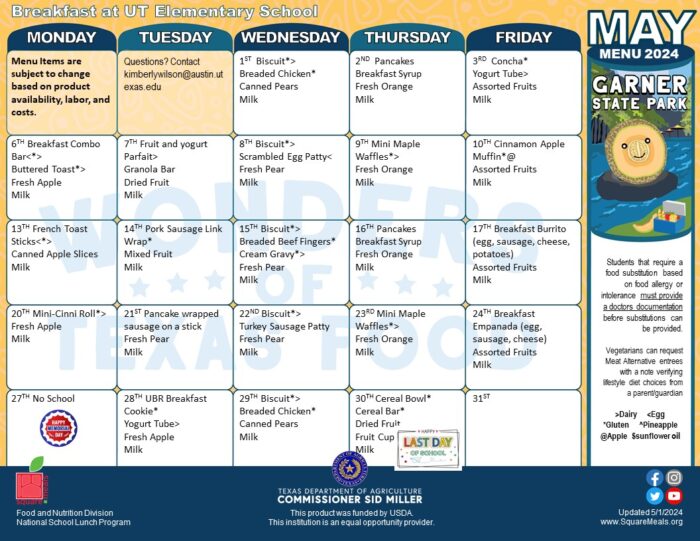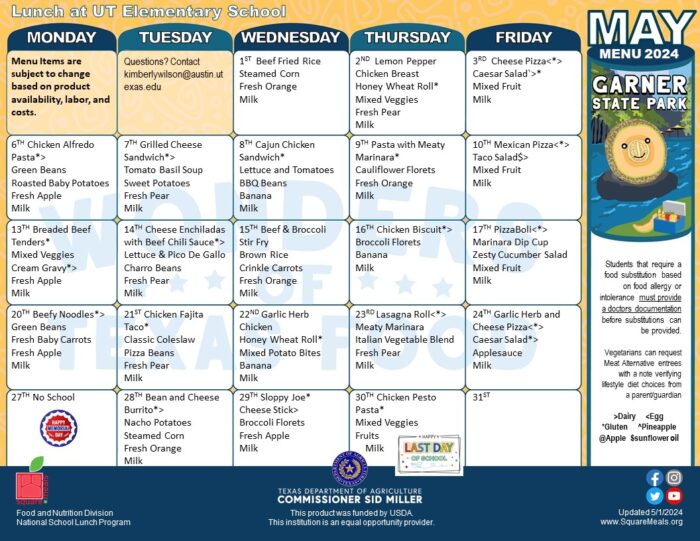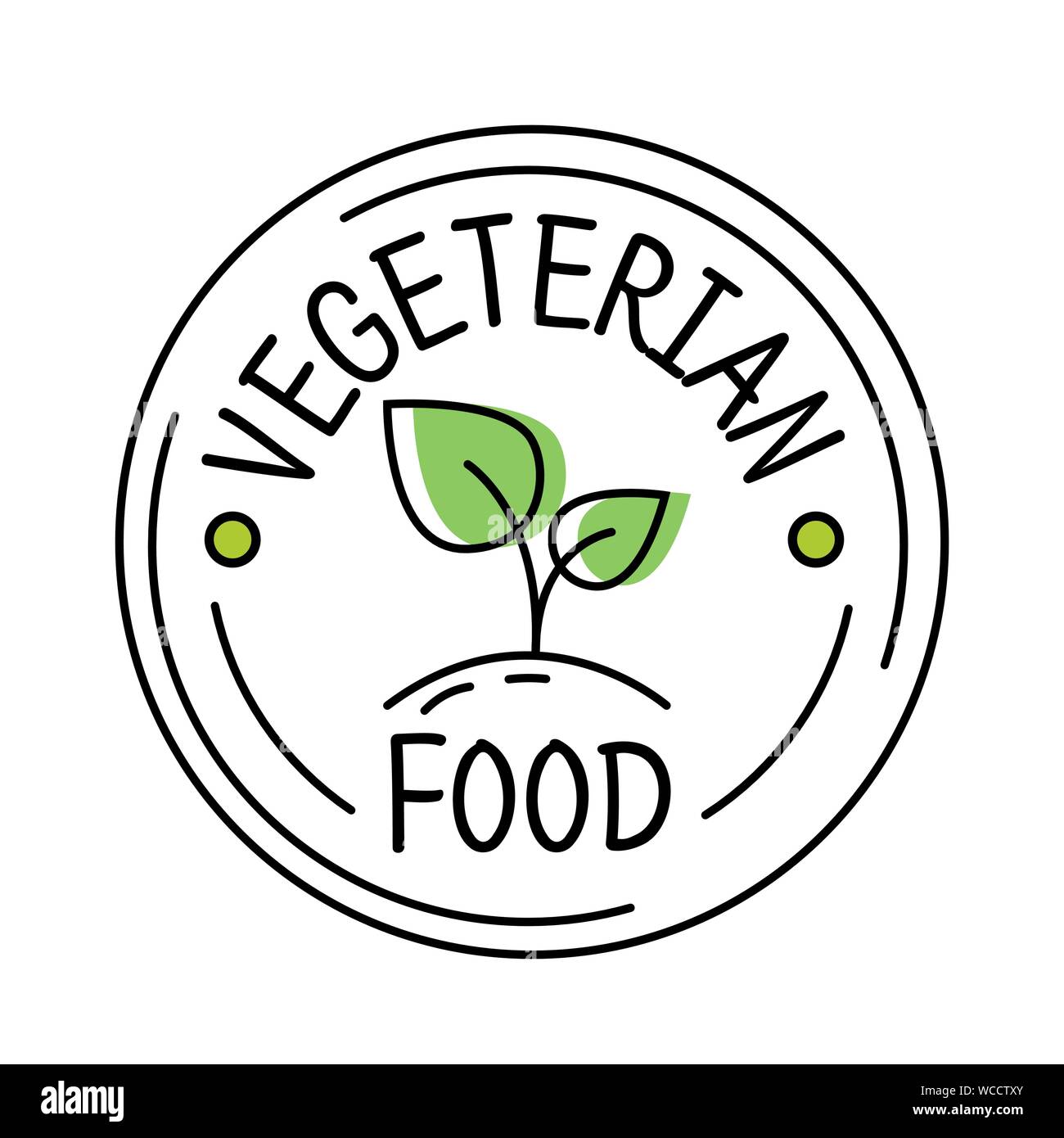Healthy Summer Meals Make a Difference
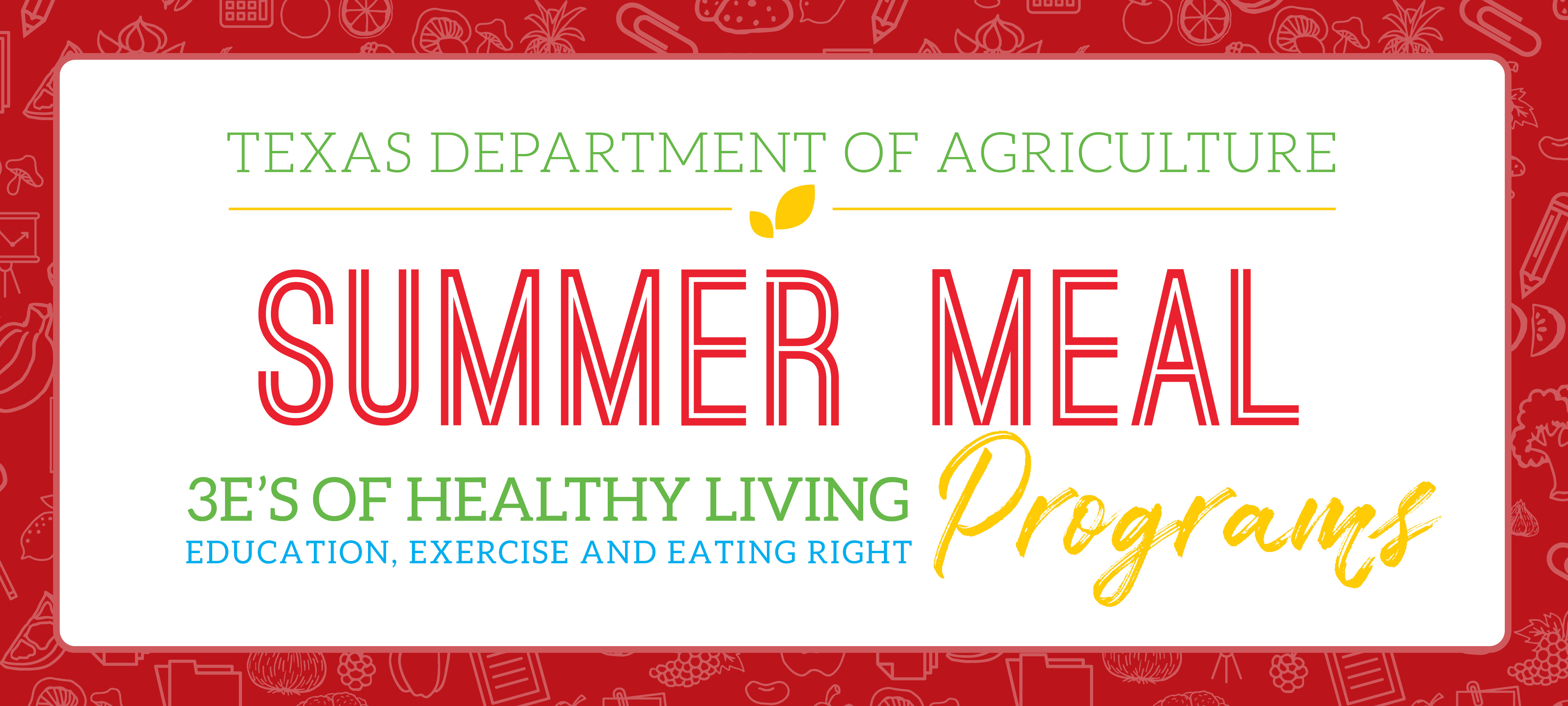
Wondering what’s in store for you and your children when you arrive at a summer meal site? Expect welcoming faces in a supervised setting, and a healthy, meal at no cost to children 18 and younger and eligible people with disabilities. Meal site schedules are subject to change. Please call to confirm dates, times and meal-service details. For more information, parents should visit SummerFood.org. |
Federal and State Standards for the National School Lunch Program:
- Foods with Minimal Nutritional Value (FMNV) are restricted during 7:10 a.m. to 3:30 p.m. This includes candy, soda, popsicles, chips, and caffeinated beverages, including energy drinks.
- Competitive Foods, including all food and beverages that are not provided by school foodservice, may not be consumed on campus.
- Three school events throughout the school year may be designated as a special time for consuming FMNV determined by the school administrator. Typically Thanksgiving, Winter Holiday, and End Of Year Parties.
- Parents providing their child’s lunch may not provide food to any other child other than their own. Purchased food not made from home (McDonalds, Sonic, Dominos, ect.) must be eaten outside the cafeteria at the picnic tables.
Thank you for your cooperation and understanding!
Eat like a little longhorn…
Breakfast 7:15am-7:50am & Lunch 10:45am- 1pm
Full Lunch Tray $6 (Ice Tea included)
Full Breakfast Tray $5 (Coffee included)
Coffee $2 **50₵ discount on coffee if you bring your own cup!!
Just Entrée $3
Just a side $2
Just Fruit $1
Milk Carton 50₵
Iced Tea (refills included) 50₵
Executive Chef • Kimberly Wilson • July 2013 – present
This is Chef Kimberly’s 10th school year at UTES. Running the Child Nutrition Program as the Executive Chef for the last 4 years. Previously operating the cold food department in the Jester production center on the UT main campus for almost 3 years. Kimberly has a Degree in Culinary Arts and been in the restaurant and hospitality management industry for the past 19 years.
Sous chef • Nicole Jones • October 2021 – present
Nicole Stevens joined our kitchen as the Sous Chef during our 2021-2022 school year. Nicole has over 25 years of hospitality experience. Previously working at the UT Early Child Development Center as the Lead Cook for 3.5 years. Nicole’s focus on child nutrition led her to join our team and continue to watch our little longhorns grow. Her favorite lunch to cook here at UTES is our Beef Fried Rice and the Lemon Pepper Chicken!
Have you seen Chef Kimberly’s pet crab Kobe?
Kobe is a climbing crab from Hawaii and is in the grandson of Chef Kim’s old crab Wanneta. He enjoys hiding in odd places around the kitchen and spying on the kids in the service line. Every night he climbs around the café in search of bits of food and a new place to hide. He spent the summer sneaking around the school. The slideshow of his adventures is on display in the cafeteria info screens. Look out though, do not get too close to Kobe or you may get pinched! He’s a snappy little crabby!!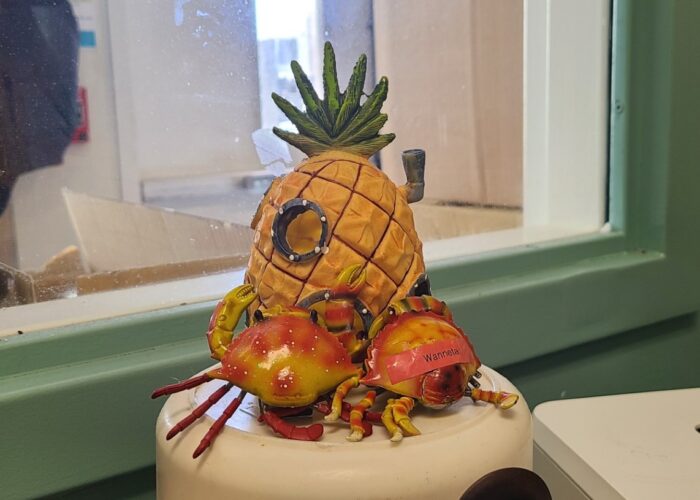
When in line at the café look around the kitchen and tell the chef’s if you see him…
Yes we do that!
Each dish has a meatless option for students that live a constant vegetarian lifestyle. Any student that wishes to be on the vegetarian list will need have a parent or guardian communicate directly to Chef Kimberly. This way we can all be in the loop and be sure the item will be available for their specific student.
Vegetarian Items we use in place of meat in all our dishes:
- HINOICHI extra firm tofu blocks
- Morning Star meatless breakfast sausage patty
- Morning Star Meatless Chicken Nugget
- Garden Burger Meatless Black Bean Patty
- Kraft Meatless Patty Boca 3/1
- PlantFare Plant Protein Shreds
- Kellogg’s Meatless Grillers Crumble
- OUMPH! Meatless Chunks
- Field trip sack lunch: Tofurky Deli Slices
 Food Allergies -We got you covered…
Food Allergies -We got you covered…
Students that require a food substitution based on food allergy or intolerance must provide a doctors documentation before substitutions can be provided. When this is available a full and safe substitute will be provided as a replacement. When reviewing our food menu look for these icons to help identify items that your student may react to.
>Dairy <Egg *Gluten ^Pineapple @Apple $sunflower oil
What Are the Most Common Food Allergies?
Kids can be allergic to any food, but these cause most food allergy reactions:
- peanuts and other nuts
- seafood, such as shrimp
- fish
- milk, particularly cow’s milk
- eggs
- soy
- wheat
- sesame
In the most serious cases, a food allergy can cause anaphylaxis (say: ah-nuh-fuh-LAK-sis). This is a sudden, severe allergic reaction in which several problems happen all at once. It can involve the skin, breathing, digestion, the heart, and blood vessels. A person’s blood pressure can drop, breathing tubes can narrow, and the tongue can swell.
People at risk for this kind of a reaction have to be very careful and need a plan for handling emergencies, when they might need to get special medicine to stop these symptoms from getting worse.
Many kids outgrow allergies to milk and eggs as they grow older. But severe allergies to foods like peanuts, some kinds of fish, and shrimp often last a lifetime.
No matter how hard you try, you may eat the wrong thing by accident. Stay calm and follow your emergency plan. What’s an emergency plan? Before a slip-up happens, it’s a good idea to create a plan with your doctor and parents. The plan should spell out what to do, who to tell, and which medicines to take if you have a reaction.
This is especially important if you have a food allergy that can cause a serious reaction (anaphylaxis). For serious reactions, people may need a shot of epinephrine (say: eh-pih-NEF-rin) with them. This kind of epinephrine injection comes in an easy-to-carry container that looks like a pen. You and your parent can work out whether you carry this or someone at school keeps it on hand for you. You’ll also need to identify a person who will give you the shot.
If you get an epinephrine shot, you will need to go to the hospital or a medical facility, where they can keep an eye on you and make sure the reaction is under control.
![]()
Green is the New Burnt Orange
by Jessica Sinn
Just around the corner from the University Elementary School cafeteria, a class of second-graders is sitting on tree stump chairs and watching their teacher point to sketches of plants on a handheld white board.
“Alright! Now I want you all to break into groups and search for this herb,” says Rebecca Vore, the school’s wellness teacher, as she taps her finger to the word “Basil.”
While the young gardeners scavenge for a patch of green leaves, a student walks up to Vore with a plant crawling with microscopic bugs.
“Those are aphids,” Vore says. “The ladybugs eat them.”
For a moment, the boy stares down at the insects in wonderment.
“Well then we shouldn’t get rid of them because we need our ladybugs,” he exclaims. “This is why we don’t need pesticides in the garden.”
Vore watches her student with delight as he runs back to the garden to share his newfound wisdom with the group.
“You don’t have to spell everything out to them,” she says. “You just have to guide them and let them make these connections on their own.”
It’s Only Natural
When students understand and appreciate their intrinsic bond with nature, they’re able to develop a deeper appreciation for both plant and human life, Vore says. These gardens, she adds, are really outdoor classrooms where children learn valuable lessons—not just about long-term health, but also about science and math, even business.
“They need to have that connection to understand their place in this world,” says Vore, who is proud to work at a school that uniquely offers gardening classes to students of all K-12 grade levels. “If you’re in touch with your sense of place, your sense of self will follow. You can look around and say, ‘Yes, I am a part of all of this.’”
Like scientists in a lab, Vore’s students weave around the leafy garden beds observing the wonders of photosynthesis, insect larvae and metamorphosis. They’re sifting through dirt in search of beetles and busily jotting down notes about their findings. This type of fieldwork, Vore says, is the impetus for world-changing innovations—from flight to sonar to electricity.
“In order for them to be prepared for whatever is coming next, they need to put ideas together, make predictions and use their cognitive reasoning skills,” Vore adds. “The best way to do that is by getting their hands dirty.”
UT Elementary alumnus Christian Flores, says he will never forget his time in the garden, where he planted seeds and watched them morph into edible herbs and vegetables. Inspired by his fondest elementary school memories, he recently built five tables and six benches for the garden as part of his Eagle Scout project.
“I really enjoyed being out in the garden and working with my hands,” says Flores, who has enlisted in the U.S. Navy and plans on becoming a combat medic. “It was gratifying watching the plants grow and knowing that I had a part in that.”
The Fruits of their Labors
One of the biggest perks for the students, Vore adds with a laugh, is getting down and dirty. And though her students aren’t aware of it, they’re getting a bonus PE class while moving soil, carrying heavy watering cans and pushing wheelbarrows. Sometimes Vore will catch a student surreptitiously munching on a leafy snack.
“I remember this one student who looked like he had his hand caught in the cookie jar,” Vore recalls, smiling. “He had a piece of sorrel in his hand and said apologetically, ‘I just wanted a snack.’ “I just laughed and told him that if he wants to eat sorrel, go right ahead.” As part of the school’s Healthy Families Initiative, the gardening program promotes physical activity and healthy nutrition for children and their families.
“It’s like ripples in a pond,” she says. “When they get home, they inspire their families to visit the
produce aisle and experiment with healthy recipes.”
They learn those recipes in the cafeteria where Kimberly Wilson, the school’s executive chef, shows them how to make healthy snacks such as kale chips and salads with homemade dressing. They even get to taste-test some entrees when Wilson prepares to change the menu. UT Elementary is one of the few schools in Austin that prepares and serves food in-house by professionally trained chefs.
“We serve a lot items that many of these kids—and adults—would not be exposed to at home,” Wilson says. “Expanding the palates of the students will help them make better food choices as they grow. If they know what real homemade food is supposed to look and taste like, they will be more aware when they are eating less healthy food.”
In the spirit of healthy eating, the students sell their harvested goods at the local farmers market, where they often meet restauranteurs in need of fresh, locally grown produce. Restaurant owner Sam Hellman-Mass enjoys bartering with the young vendors and taking their produce back to his East Sixth Street establishment, Suerte. In the future he aspires to give culinary lessons at the school.
“As a restaurant we have a great opportunity to spark some positive change,” Hellman-Mass says. “If we can make a small impact, any impact really, on helping our community have access to better ingredients and cook more and enjoy food more, I think that’s a worthwhile endeavor.”
Good Stewards
Like Hellman-Mass, the Little Longhorns are working toward making a positive difference here in Austin and around the world. Whether they’re carrying buckets of water around Ladybird Lake to raise money for well water in Africa or recycling and composting waste to diminish landfill buildup, the young environmentalists are learning how to become good stewards of the land. Their efforts were rewarded by the school’s community partner Keep Austin Beautiful, a nonprofit that promotes environmental stewardship among the Austin community. In 2017, students and teachers proudly accepted the Applied Materials Education Award at the annual Beautify Bash. The school has also partnered with Texas Parks and Wildlife, a state agency that oversees and protects wildlife and their habitats. Through these partnerships, conservation experts visit the school to teach lessons in recycling, composting, water health and more. Students also go on field trips to McKinney Falls State Park, where they learn how to become certified anglers.
“We do catch and release, but mostly they’re learning how to cast out their line into the water,” Vore
says. “They get to see the park, learn about fish habitats and rules and regulations for fishing. It’s great for them to learn about these resources and how to properly use them.” Whether they’re casting out into the gentle rapids of McKinney Falls or loading their baskets with herbs and vegetables in the garden, the students are adopting healthy lifestyle choices that they can pass along to their families. That’s the goal of the Healthy Families Initiative, which was launched in 2007 as a result of some concerning data from the student body-mass-index report. According to the analysis, 67 percent of students were in the obese/overweight zone during the 2007-08 academic year. That number has dropped down to 41 percent in 2016-17 and continues to decline.
“We teach very young children, so these results were really a wake-up call to our community,” says UT Elementary School Superintendent Dr. Mellissa Chavez. “We know that students’ brains work better when their bodies are healthy so we needed to be proactive and address this issue.”
After a gardening session, Vore sees these benefits when her students return to the classroom refreshed and eager to probe deeper into their observations. Now is the time, she says, for young people to step away from the screen and get back in touch with the natural world.
“I cannot tell you about how many children who’ve told me about all the gardening their grandparents did,” Vore says. “Somehow, it skipped a generation or two, so we need to get them to reconnect with the environment and to have them become vocal, educated, concerned adults.”



